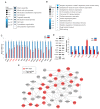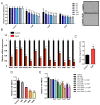The RNA-Binding Protein Musashi1 Regulates a Network of Cell Cycle Genes in Group 4 Medulloblastoma
- PMID: 35011618
- PMCID: PMC8750343
- DOI: 10.3390/cells11010056
The RNA-Binding Protein Musashi1 Regulates a Network of Cell Cycle Genes in Group 4 Medulloblastoma
Abstract
Medulloblastoma is the most common malignant brain tumor in children. Treatment with surgery, irradiation, and chemotherapy has improved survival in recent years, but patients are frequently left with devastating neurocognitive and other sequelae. Patients in molecular subgroups 3 and 4 still experience a high mortality rate. To identify new pathways contributing to medulloblastoma development and create new routes for therapy, we have been studying oncogenic RNA-binding proteins. We defined Musashi1 (Msi1) as one of the main drivers of medulloblastoma development. The high expression of Msi1 is prevalent in Group 4 and correlates with poor prognosis while its knockdown disrupted cancer-relevant phenotypes. Genomic analyses (RNA-seq and RIP-seq) indicated that cell cycle and division are the main biological categories regulated by Msi1 in Group 4 medulloblastoma. The most prominent Msi1 targets include CDK2, CDK6, CCND1, CDKN2A, and CCNA1. The inhibition of Msi1 with luteolin affected the growth of CHLA-01 and CHLA-01R Group 4 medulloblastoma cells and a synergistic effect was observed when luteolin and the mitosis inhibitor, vincristine, were combined. These findings indicate that a combined therapeutic strategy (Msi1 + cell cycle/division inhibitors) could work as an alternative to treat Group 4 medulloblastoma.
Keywords: Musashi1; RNA-binding protein; cell cycle regulation; luteolin; medulloblastoma.
Conflict of interest statement
The authors declare no conflict of interest.
Figures





Similar articles
-
The RNA-binding protein Musashi1 affects medulloblastoma growth via a network of cancer-related genes and is an indicator of poor prognosis.Am J Pathol. 2012 Nov;181(5):1762-72. doi: 10.1016/j.ajpath.2012.07.031. Epub 2012 Sep 14. Am J Pathol. 2012. PMID: 22985791 Free PMC article.
-
Musashi1 modulates cell proliferation genes in the medulloblastoma cell line Daoy.BMC Cancer. 2008 Sep 30;8:280. doi: 10.1186/1471-2407-8-280. BMC Cancer. 2008. PMID: 18826648 Free PMC article.
-
Luteolin inhibits Musashi1 binding to RNA and disrupts cancer phenotypes in glioblastoma cells.RNA Biol. 2018;15(11):1420-1432. doi: 10.1080/15476286.2018.1539607. Epub 2018 Nov 18. RNA Biol. 2018. PMID: 30362859 Free PMC article.
-
RNA binding protein-mediated post-transcriptional gene regulation in medulloblastoma.Mol Cells. 2014 May;37(5):357-64. doi: 10.14348/molcells.2014.0008. Epub 2014 Mar 6. Mol Cells. 2014. PMID: 24608801 Free PMC article. Review.
-
Intracellular functions of RNA-binding protein, Musashi1, in stem and cancer cells.Stem Cell Res Ther. 2020 May 24;11(1):193. doi: 10.1186/s13287-020-01703-w. Stem Cell Res Ther. 2020. PMID: 32448364 Free PMC article. Review.
Cited by
-
The paralogues MAGOH and MAGOHB are oncogenic factors in high-grade gliomas and safeguard the splicing of cell division and cell cycle genes.RNA Biol. 2023 Jan;20(1):311-322. doi: 10.1080/15476286.2023.2221511. RNA Biol. 2023. PMID: 37294214 Free PMC article.
-
The Neurodevelopmental and Molecular Landscape of Medulloblastoma Subgroups: Current Targets and the Potential for Combined Therapies.Cancers (Basel). 2023 Jul 30;15(15):3889. doi: 10.3390/cancers15153889. Cancers (Basel). 2023. PMID: 37568705 Free PMC article. Review.
References
-
- Kieffer V., Chevignard M.P., Dellatolas G., Puget S., Dhermain F., Grill J., Valteau-Couanet D., Dufour C. Intellectual, educational, and situation-based social outcome in adult survivors of childhood medulloblastoma. Dev. Neurorehabil. 2019;22:19–26. doi: 10.1080/17518423.2018.1424262. - DOI - PubMed
-
- King A.A., Seidel K., Di C., Leisenring W.M., Perkins S.M., Krull K.R., Sklar C.A., Green D.M., Armstrong G.T., Zeltzer L.K., et al. Long-term neurologic health and psychosocial function of adult survivors of childhood medulloblastoma/PNET: A report from the Childhood Cancer Survivor Study. Neuro Oncol. 2017;19:689–698. doi: 10.1093/neuonc/now242. - DOI - PMC - PubMed
Publication types
MeSH terms
Substances
Grants and funding
LinkOut - more resources
Full Text Sources
Research Materials
Miscellaneous

